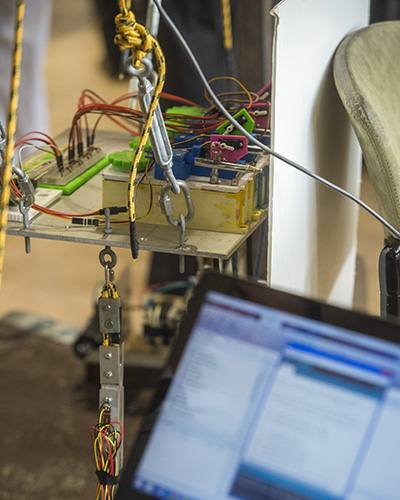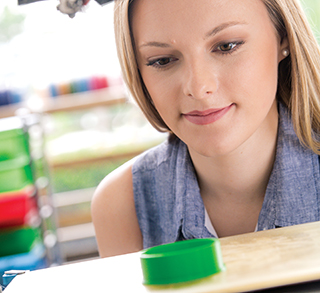 The two-semester course requires students to work in teams, design a viable product and build a working prototype.For students in the School of Engineering, the Capstone Senior Design course is a rite of passage. The two-semester course requires students to work in teams, calling on all of their classroom knowledge to design a viable product and build a working prototype.
The two-semester course requires students to work in teams, design a viable product and build a working prototype.For students in the School of Engineering, the Capstone Senior Design course is a rite of passage. The two-semester course requires students to work in teams, calling on all of their classroom knowledge to design a viable product and build a working prototype.
But what happens when an unprecedented disruption puts an end to in-person collaboration weeks before the projects are completed?
That was the challenge facing seniors in spring of this year when the worldwide COVID-19 outbreak led the university to transition to online classes. The design teams were unable to meet in person and building a working prototype became all but impossible.
“Transitioning to online learning with little time to prepare was a challenge for everyone, but for senior design, it was especially disruptive,” said Alan Eberhardt, Ph.D., director of the Capstone Senior Design Course in the Department of Biomedical Engineering. “Building, testing and validating the functionality of students’ design projects, all of which involves hands-on teamwork, is usually 30% of the final grade. So, we had to completely re-think how we could fairly evaluate the students’ work.”
“...building working prototypes... became one of the challenges. How do we address an impossible situation without letting students off the hook?” |
The result was that Eberhardt and Dale Feldman, Ph.D., who serves as a co-instructor, revised their grading rubric by removing the 30 percent prototype component and distributing those points among several other requirements, such as a final report containing an extensive Risk/Benefit analysis and a scientific poster.
“One of the strengths of this course is that students are building working prototypes for clients to address real-world challenges,” Eberhardt said. “So that became one of the challenges. How do we address an impossible situation without letting students off the hook?”
In the end, Eberhardt said, some projects were better suited for these alternate circumstances than others. For example, one team had planned to create an “empathy app.” The final prototype was a web-based application designed to help people comprehend the challenges of living with hearing impairment.
“Designing a web-based application is not what most people think of as a typical biomedical engineering senior design project,” said Paige Severino. She and team members Nicholas Castro, Elam Cutts and Garrett Wood developed a working prototype of their project — a web-based application for simulating auditory perception in individuals with impaired hearing — for the Alabama Department of Rehabilitation Services. “The non-traditional project where you don’t have a shiny, physical prototype actually turned out to be one that was well-suited for remote collaboration.”Despite those advantages, the team still experienced some roadblocks when it came to delivering a final product. “We weren’t immune to the disruption of the COVID-19 pandemic,” Severino said. “The transition to online learning, the anxiety of the situation and the disappointment in not being able to complete senior year in the traditional way resulted in some distraction.”“Our team spent a lot of time learning about back-end development and taking programming courses through Youtube, but it paid off in the end. The non-traditional project where you don’t have a shiny, physical prototype actually turned out to be one that was well-suited for remote collaboration.”
“The non-traditional project where you don’t have a shiny, physical prototype actually turned out to be one that was well-suited for remote collaboration.”Despite those advantages, the team still experienced some roadblocks when it came to delivering a final product. “We weren’t immune to the disruption of the COVID-19 pandemic,” Severino said. “The transition to online learning, the anxiety of the situation and the disappointment in not being able to complete senior year in the traditional way resulted in some distraction.”“Our team spent a lot of time learning about back-end development and taking programming courses through Youtube, but it paid off in the end. The non-traditional project where you don’t have a shiny, physical prototype actually turned out to be one that was well-suited for remote collaboration.”
Unlike some other teams, Severino says her team was able to complete a prototype, but the verification and validation testing the team had planned was not completed.
“Although the application is not currently available on the web, we did create a public GitHub repository to house all of the code and documentation necessary to continue the project and bring it to completion. With this repository, anyone can access the code, add their own and continue to develop the application to the point where it can be deployed,” Severino said.
One of the objectives in every project is to learn to work within realistic design constraints, including budget, materials, time constraints, etc.” said Eberhardt. “So in that sense, it was interesting to see how teams attempted to adapt to the challenge. But that’s not to say this was a net positive.
Lessons from a pandemicUAB faculty are devising new paths to advance education and professional development for students in spite of remote learning — and because of it. |
"This semester was a challenge for everyone, and I’m proud of how this senior class responded. I hope it was a valuable experience,” he said.
“Overall, our original goal of releasing Audemo V.1 was slightly changed,” Severino said, “but we are happy with the progress we made and the deliverables that are out there in the public domain ready for collaboration and future development.”
This was adapted from a story written by Grant Martin, director of communications for the UAB School of Engineering. Read the full story.
